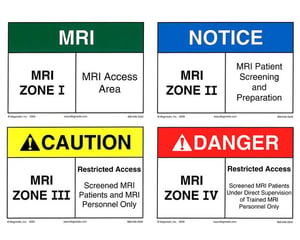Magnetic Resonance Imaging (MRI) All individuals responsible for safety in Zones III or IV of the MR environment should be documented as having been successfully educated regarding MR safety issues.
Imaging Centers - Annually Required Compliance Education
 Meeting compliance requirements can be confusing and difficult. The required compliance education serves several purposes. Annual training is not only an important part of ensuring patient safety and the safety of your team members, it also affects reimbursement from private insurance companies and the Centers for Medicare & Medicaid Services (CMS).
Meeting compliance requirements can be confusing and difficult. The required compliance education serves several purposes. Annual training is not only an important part of ensuring patient safety and the safety of your team members, it also affects reimbursement from private insurance companies and the Centers for Medicare & Medicaid Services (CMS).
The Joint Commission, American College of Radiology (ACR), Intersocietal Accreditation Commission (IAC), States, and municipalities all require annual safety training for Fluoroscopic Radiation, CT Dose Optimization and Reduction, and Magnetic Resonance Imaging (MRI) for Level I and Level II staff.
 Magnetic Resonance Imaging (MRI) All individuals responsible for safety in Zones III or IV of the MR environment should be documented as having been successfully educated regarding MR safety issues (in a manner defined by the facility’s MRMD) at least to a level sufficient to ensure that they do not represent a danger to themselves or others in the MR environment. Such MR safety educational participation should be repeated annually, and appropriate documentation should be maintained to confirm this ongoing MR safety educational effort. These individuals will be referred to as MR Personnel. Note that that this level of training is more in depth and formal than that which might be provided to Non-MR Personnel, as described in the following paragraph.
Magnetic Resonance Imaging (MRI) All individuals responsible for safety in Zones III or IV of the MR environment should be documented as having been successfully educated regarding MR safety issues (in a manner defined by the facility’s MRMD) at least to a level sufficient to ensure that they do not represent a danger to themselves or others in the MR environment. Such MR safety educational participation should be repeated annually, and appropriate documentation should be maintained to confirm this ongoing MR safety educational effort. These individuals will be referred to as MR Personnel. Note that that this level of training is more in depth and formal than that which might be provided to Non-MR Personnel, as described in the following paragraph.
Individuals who have not successfully attained this level of MR safety education will be referred to as Non-MR Personnel. Specifically, Non-MR Personnel will be the terminology used to refer to any individual who has not within the previous 12 months successfully undergone the designated formal MR safety education defined by the MRMD of that installation necessary to qualify as MR Personnel.
Personnel.
MR Technologists
MR technologists should comply with the technologist qualifications listed in the ACR MRI
There are 2 levels of MR Personnel, as described below.
Level 1 MR Personnel: Individuals who have passed the facility’s MR safety educational requirements (as defined by the facility’s MRMD) to ensure that they would not constitute a danger to themselves or others in the MR environment will henceforth be referred to as Level 1 MR Personnel.
Course Options
Level 2 MR Personnel: Those who have been more extensively trained and educated in the broader aspects of MR safety issues, including but not limited to issues related to the potential for RF-related thermal loading or burns and direct neuromuscular excitation from rapidly changing gradients, will henceforth be referred to as Level 2 MR Personnel.
Course Options
Below is an excerpt regarding the American College of Radiology (ACR) MR Screening from the American College of Radiology (ACR) Manual on MRI Safety. We’ve added the excerpt below and included a full link to the manual as well. If you have any questions, let us know and a member of our team will follow-up with you.
Excerpt from the American College of Radiology (ACR) Manual on MR Safety: (full manual, https://www.acr.org/-/media/ACR/Files/Radiology-Safety/MR-Safety/Manual-on-MR-Safety.pdf)
MR SCREENING
All Non-MR Personnel needing to enter Zone III must first pass an MR safety screening process. Before Non-MR Personnel enter Zone III, final authorization must originate from Level 2 MR Personnel.
Nonemergent patients should be MR safety screened at least twice prior to being granted access to the MR environment. At least 1 of these screens should be performed by Level 2 MR Personnel verbally and/or interactively. For example, the patient (or their health care proxy) may complete a screening form and subsequently have the responses and contents of that form reviewed together with a Level 2 MR Technologist.
Emergent patients and their accompanying Non-MR Personnel may be screened only once, provided that the screening individual has Level 2 MR Personnel status. Any exceptions to this (such as but not limited to cases where a screening induced delay may result in imminent patient paralysis, blindness, and/or death) must be with the mutual agreement of the ordering physician and covering Level 2 MR Physician, who specifically acknowledge the potential risks of a decision NOT to screen prior to granting that patient MR access.
The screening process and forms for patients, Non-MR Personnel, and MR Personnel should be essentially identical. Specifically, one should assume that screened Non-MR Personnel, health care practitioners, or MR Personnel might enter the bore of the MR system and be exposed to the static and/or time-varying magnetic fields at any time.
Examples of this include if a pediatric patient cries for his mother, who then leans into the bore of the scanner, or if an anesthesiologist leans into the bore to manually ventilate a patient in the event of a problem.
Careful screening for ferromagnetic materials by direct inspection and use of a ferromagnetic detector is recommended prior to entering Zone IV. MR Conditional devices may be ferrous, which can lead to activation of ferromagnetic detectors prior to entry into Zone IV. The manufacturers of ferromagnetic detectors today do not claim utility or sensitivity for screening of implants or foreign bodies within patients, although if sufficiently large and/or superficial, implant detection may be possible.
Staff/Personnel Screening
All MR Personnel are to undergo an MR screening process as part of their employment agreement to ensure their safety in the MR environment. For their own protection and for the protection of the Non-MR Personnel under their supervision, all MR Personnel must immediately report to the MRMD any trauma, procedure, or surgery they experience or undergo where a ferromagnetic object or device may have become introduced within or on them. This will permit appropriate screening of the employee to determine the safety of permitting that employee into Zones III and/or IV.
.png?height=120&name=Altus(White).png)